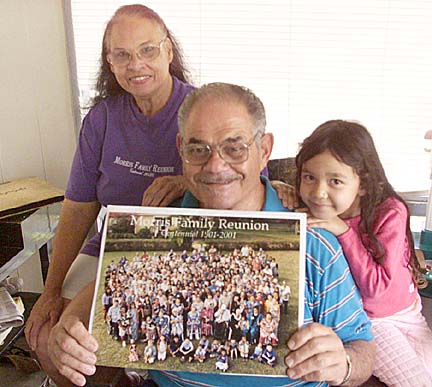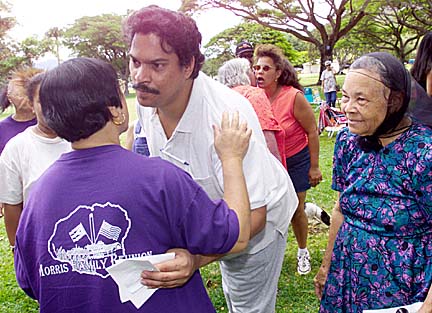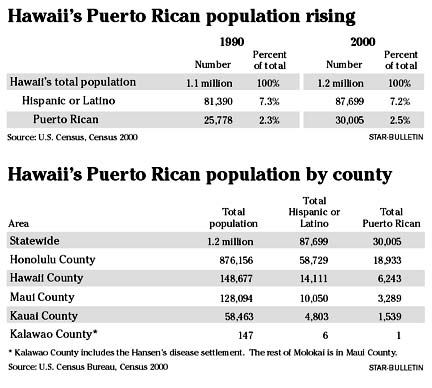


Puerto Rican When 150 members of the Morris clan showed up at the 10th annual family reunion at Kapiolani Park last month, there were two distinct greetings, depending on gender.
roots take hold
The Morris clan is part
of a growing isle groupHISPANIC HAWAII
Kelliann Shimote / kshimote@starbulletin.com
There was the kiss on the cheek, followed by a hug for the women; a handshake and embrace for the men.
One hundred years after Serafin and Juana Morris left their home in Puerto Rico to work in the sugar fields of Hawaii, their descendants still hold on to their food and music of a distinctly different island culture thousands of miles away.
The descendants of the Morrises are part of a small but growing population segment in Hawaii. Census 2000 showed that 87,699 residents described themselves as Hispanic or Latino, nearly 8 percent more than in 1990. Of those residents, 30,005 described themselves being of Puerto Rican descent, 16 percent more than 10 years earlier.
In the Morris clan, a big part of their Puerto Rican heritage is the food brought to Hawaii by their ancestors.
Donna Pilikai, 41, great-great-granddaughter of Serafin and Juana Morris, said there are no cup or teaspoon measurements to follow in the recipes she's learned.

Everything is measured by the palm of the hand, she said. Already, she has assured that the next generation will know how to do things by having her daughter help make pasteles, ground green bananas with meat and achiote oil rolled in banana leaves, ti leaves or tin foil."I feel that I need to take the tradition on," Pilikai said. "We would want to continue the tradition ... hope that it continues on for years and years."
James Rodrigues, 70, meanwhile, describes music with Puerto Rican roots mixed with an island flavor. "It (is) catchy ... your toe start moving, your feet start moving," he said.
Pilikai and Rodrigues were among those at the reunion who could trace their roots back to the first Morrises who called Hawaii home.
"The whole idea is just to know family," 46-year-old Paul Ho'okano -- great-great-grandson of Serafin and Juana Morris -- said of the reunion. "It's big but we just want everyone to be close ... it's all part of the bloodline to ... reflect and just to enjoy each one's company."
The family remains close despite being spread throughout Kauai, Oahu, the Big Island and the mainland.
The family name originated from the French name Mori, but was misspelled when they arrived in Hawaii in 1901.

The family saga began when Serafin and Juana Morris left Puerto Rico by boat to Louisiana in March 1901. They were contract sugar cane laborers on voyage to Honolulu. They were accompanied by their five children. However, Ignacio, just a year old, didn't survive the voyage and was buried in New Orleans.The family traveled by train from Louisiana to California.
From California, they boarded a ship for Kauai, destined for their new home -- the Koloa Sugar Plantation. The family arrived in April 1901.
While working at the plantation, the couple eventually had 11 more children, among them Juana Maria "Mary" Morris.
Juana met Elario Rodrigues on the plantation, and they were married on Feb. 8, 1918. Richard Rodrigues, their youngest son, said the couple met through the plantation, when they would have normal gatherings of less than 100 people on the weekends.
This union foreshadowed a line of descendants numbering close to 300.
In search of better job opportunities, the couple moved with their 10 children to Oahu in 1931. Elario found a job at the University of Hawaii experiment station on Tantalus. Their last child, Richard, was born on March 24, 1934.
Of the 11, only four are still alive, including 70-year-old James Rodrigues.
James' memories include the bombing of Pearl Harbor, his first job and his retirement as a construction worker. He remembered his father as a man of great knowledge and his mother as the money-saver in the family.
His younger brother Richard also remembers the moment when Japan bombed Pearl Harbor on Dec. 7, 1941.
"James and I were outside waiting to go to church and saw the (Japanese) planes flying over," said Richard. "(You) could see the smoke (and) hear the noise."
During the two years after the bombing, he remembers carrying a foot-long bag containing a mask to protect himself in case of mustard gas attacks, while going to Kalihi Uka Elementary School.
James got his first job, consisting of yard work, at his father's workplace.
"I never did like school, so at 13 (my father) asked (his) boss if I could work part-time," he said. "I used to love to work. For that year (1944), I made $444." He gave all his earnings to his parents.
"Puerto Rican style (is) you give to parents and they take care of you. My mother was always the one fo' save."
James developed rheumatic fever three months after his father died of lung and liver cancer on March 1, 1952.
"I remember one night, I went to bed and (it felt like) someone taking a rope and pulling (the) rope from either side of me. The pain was so great," he said. "I was what, 21 years old, and the whole world wen' fall on my face, everything was going wrong."
He lost 71 pounds during the year and a half he was hospitalized.
James recalled his family members in the hospital room looking at him.
"The first one I saw was my brother-in-law. (I thought) no can be one angel because he's a little bit too dark," he chuckled.
In the summer of 1958, he met his future wife Hazel Hosino.
"I wouldn't let any woman pass me by, I was fat and everything but that wouldn't stop me," James said.
While dating for four years, he decided he needed money for their wedding.
On Jan. 3, 1962, he became a construction worker. "I started off with $2.05 an hour. When I retired (in June 1988) I made $16.39 an hour," he said.
During the family reunion, family members paid special respect to his mother, who died Aug. 6, 1969, at age 74.
James' five children and eight grandchildren are among 280 descendants from his mother's side.
"Our family is the biggest," he said. "I am proud to be Puerto Rican."